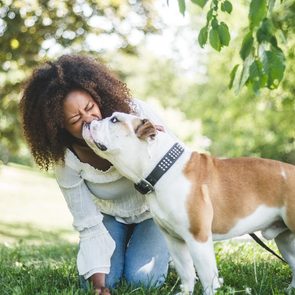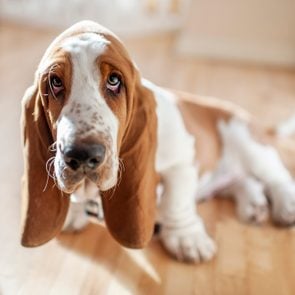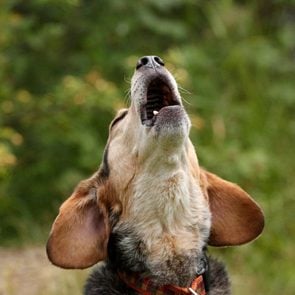Why Are Dalmatians Fire Dogs? Historians Explain
Updated: Apr. 10, 2024
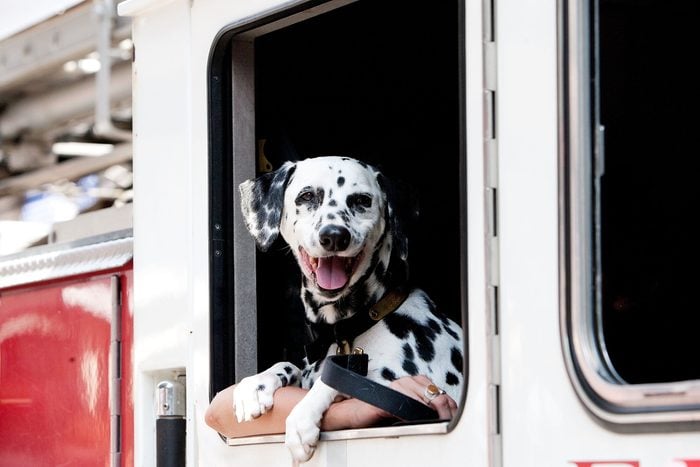
From horse escorts to much-loved mascots, these pups have been firefighters' pals for centuries. We asked breed experts and historians to explain why Dalmatians are such longstanding and famous fire dogs.
Jack the Bum, Spot and Mike are just a few of the legendary late 19th- and early 20th-century New York City canines who have contributed to the rich history and heritage of Dalmatians as fire dogs. There are tales of these dogs sprinting alongside the horse-drawn engines to alert pedestrians of their approach, bravely running into blazes with their firefighting co-workers and even nipping at the knees of horses to prevent them from falling asleep on the job. But why are Dalmatians fire dogs? And what about this black-and-white dog breed has made it such an integral part of the firefighting tradition?
The breed’s history with the fire service is almost two centuries long. “The Dalmatian has long been associated with horses and horse-drawn vehicles such as coaches, and it is generally assumed that it would have been an easy, natural transition from coaching to accompanying horse-drawn firefighting equipment,” explains Alison Merritt, the historian for the Dalmatian Club of Canada. But even after the demise of horse-drawn fire engines, Dals remain the most popular dog breed for a firehouse fixture.
We spoke to fire department and breed historians to get to the bottom of this fascinating history. Ahead, find out why Dalmatians are fire dogs and how the breed’s role has evolved from horse watchdog and fire engine escort to much-loved mascot.
Get Reader’s Digest’s Read Up newsletter for more pets, humor, travel, tech and fun facts all week long.
About the experts
Reviewed for accuracy by: Caroline Coile, PhD, an award-winning journalist specializing in canine breeds, health and science. She’s the author of 34 books, including Barron’s Encyclopedia of Dog Breeds. |
Why are Dalmatians fire dogs?
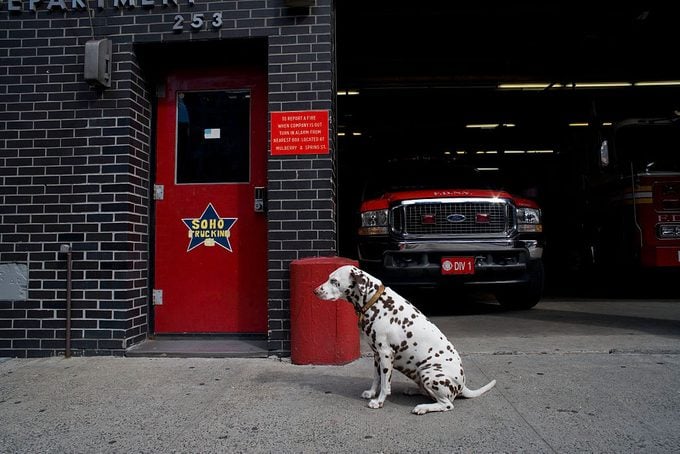
In the early years, a Dalmatian had two primary purposes as a fire dog: to clear the way for the horse-drawn engines as they raced through the streets and to offer comforting reassurance to the horses when standing beside the chaotic scene of a burning building. They may also have acted as watchdogs and companions for the horses in their stables.
When you break down the traits and background of this medium-size dog breed, it’s no surprise that the Dalmatian became the go-to dog for accompanying horse-drawn fire engines. “Dalmatians have a long history with horses and stables,” Merritt says, referring to depictions of the two together dating back to 1729.
Peggy Ann Strupp, chair of the Dalmatian Club of America Road Trials, corroborates this time scale. “According to H. Fred Lauer [author of the 1902 book The Dalmatian or Coach Dog], sporting prints depicting coaching scenes show the Dalmatian as a coach dog as far back as the 18th century,” she says.
They were bred for it
More than most breeds, the Dalmatian has an obvious affinity with equines and for accompanying moving animals or vehicles. Strupp, who has been competing in Dalmatian road trials since 1992, has firsthand experience with this. She explains that the trials are performance events designed to test the Dalmatian’s historic ability to “coach,” or follow the horses. In modern-day road trials, the handler is on horseback or in a carriage, and the Dalmatian is off-leash.
Strupp says Dalmatians are so suited to the sport (and fire dog duties) because they were bred specifically for their natural ability to adopt a coaching position, something backed up by a 1939 Harvard study. “The Dalmatian is more likely to choose a position near the horse [at the head, shoulder or side, or behind the hock], while other breeds tend to run out in front and stay there,” she says. “They also have a calming presence for the horse and make them less spooky on the trail.”
They’re fast
These spotted hounds are the ultimate endurance athletes and one of the fastest dog breeds. “The Dalmatian is built with the ideal proportions for endurance trotting [with a body slightly longer than it is high, moderate angulation and well-developed muscling] and is a very natural, functional breed without exaggerations,” Merritt says. These dogs would have no problem running alongside the fire engine carriages at high speeds and over long distances.
They’re brave and loyal
Merritt says Dals possess a willing, cooperative attitude, and their loyalty and bravery know no bounds. There are reports of these smart dogs pulling pedestrians out of the path of speeding horses and guiding people out of burning buildings.
Their hearing has nothing to do with it
It’s true that modern Dalmatians have a higher predisposition for deafness compared with other breeds. But it’s a myth that this was a factor in their selection as fire dogs. There’s no evidence to suggest firefighters wanted a dog that wouldn’t be affected by the noisy bells or sirens. In fact, many firefighter dogs would enthusiastically jump into action when the alarm was raised.
The rise of Dalmatians as firehouse dogs
Early fire engines were a far cry from the massive trucks that speed down the street with sirens blaring. “The earliest fire engines were pulled by hand to the fires by the firefighters and other helpers,” says Gary Urbanowicz, the FDNY historian at the New York City Fire Museum. “In 1832, here in New York, there was a cholera epidemic. Because so many firefighters were sick, the chief rented horses to pull the engines to the fires.”
According to Urbanowicz, the men didn’t like the fact that the horses were replacing them, so for a time, they reverted to hand-pulling the engines. This continued until the 1850s, when heavy steam-driven fire engines replaced the hand-pumped ones, and horsepower became essential.
Neither Urbanowicz nor Merritt could find any definitive reference to identify when Dalmatians first became associated with the fire service. “This information might be out there somewhere, but exact dates appear to be a bit of missing history,” Urbanowicz says. But he explains that in the 1850s and 1860s, with the reintroduction of the horses, Dalmatians started accompanying New York City fire engines, and their popularity grew from there.
“Westminster Kennel Club Dog Show began a category for fire department Dalmatians in 1910, which continued till 1940,” Merritt says. “This would indicate that there were enough Dalmatians associated with fire departments to warrant a special show class during those years.”
The evolving role of Dalmatians as firehouse dogs
“Here in New York, we started seeing the motorization of the fire engine around 1905,” Urbanowicz says. He explains that the fire horses were phased out over the next decade or so, with the last ones retiring in 1922. Often, firehouses kept the Dalmatians around anyway.
“The change in role from protecting and accompanying the horses and equipment to mascot likely occurred during this period,” Merritt says.
The public’s association with Dalmatians as faithful firehouse mascots really took hold in the 1950s. That’s when the National Fire Protection Association created Sparky the Fire Dog to act as an official fire-safety mascot. In 1955, Peg Tyndal’s story of Sparky, a stray Dalmatian adopted by the firefighters of the Batavia Fire Station in Illinois, featured in Jack and Jill magazine. “With the publication of 101 Dalmatians in 1956 and the movie appearing in 1961, Dalmatians became hugely popular, which added to their visual presence in the media and would have lent further support for them as fire-station mascots,” Merritt says.
Firehouse Dalmatians today
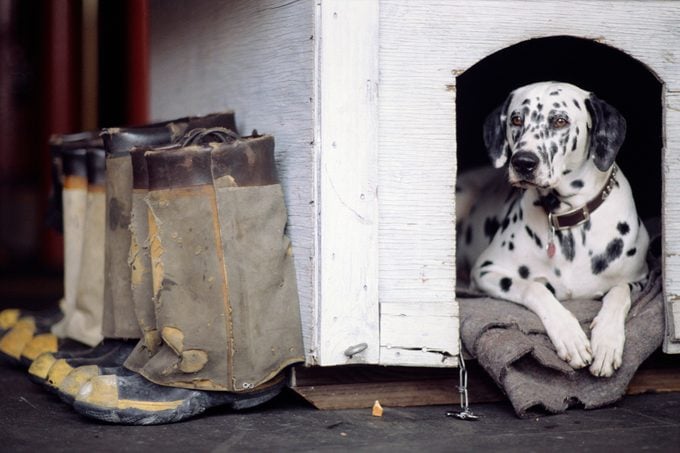
These days, the Dalmatian’s job of following the fire trucks is over. So why are Dalmatians fire dogs today? These loyal dogs remain iconic ambassadors and mascots for fire departments. Sparky the firefighter dog continues to be an educator, and Merritt says that real Dalmatians are often used to teach fire safety skills such as stop, drop and roll.
“The evolution of Dalmatians as watchdogs and firefighting escorts to mascot and support roles is a natural progression,” Merritt says. “Dalmatians are very people-oriented and empathetic, making them ideal emotional-support dogs.”
One of the most famous examples of why Dalmatians are fire dogs in modern times is Twenty. She was donated to Ladder Company 20 in the New York Fire Department after they lost seven firefighters during the collapse of the World Trade Center. Twenty brought a much-needed morale boost and accompanied the firefighters on all their calls—sitting in the truck rather than running alongside it. When Twenty passed away in 2016, the company firehouse felt empty without her. In 2021, a puppy from the same lines as Twenty joined the crew. Tank the Dal now hangs out at the firehouse, takes rides on the rig and poses for adorable pictures.
Why trust us
At Reader’s Digest, we’re committed to producing high-quality content by writers with expertise and experience in their field in consultation with relevant, qualified experts. For this piece, Gemma Johnstone tapped her experience as a writer with 15 years of experience in the pet industry, and then Caroline Coile, PhD, an award-winning journalist specializing in canine breeds, health and science, gave it a rigorous review to ensure that all information is accurate and offers the best possible advice to readers. For this piece, we relied on reputable primary sources, including historical documents, professional organizations and academic institutions, as well as our writer’s personal experience. We verified all facts and data and backed them with credible sourcing, and we will revisit them over time to ensure they remain accurate and up to date. Read more about our team, our contributors and our editorial policies.
Sources:
- Alison Merritt, historian with the Dalmatian Club of Canada; email interview, March 9, 2024
- Peggy Ann Strupp, chair of the Dalmatian Club of America Road Trials; email interview, March 7, 2024
- Gary Urbanowicz, FDNY historian at the New York City Fire Museum and author of Badges of the Bravest; video interview, March 5, 2024
- Dalmatians in Canada by John H. and Monica M. Brooks
- City of Batavia: “Sparky, the Fire Dog”
- The Sun: “Adventures of Fire House Dogs and Cats”
- Nature: “Preference of Dalmatian dogs for particular positions in coach running, and inheritance of this character”
- NFPA: “Sparky Through the Years”
- The New York Times: “Firehouse Loses a Spotted Symbol of Healing”

